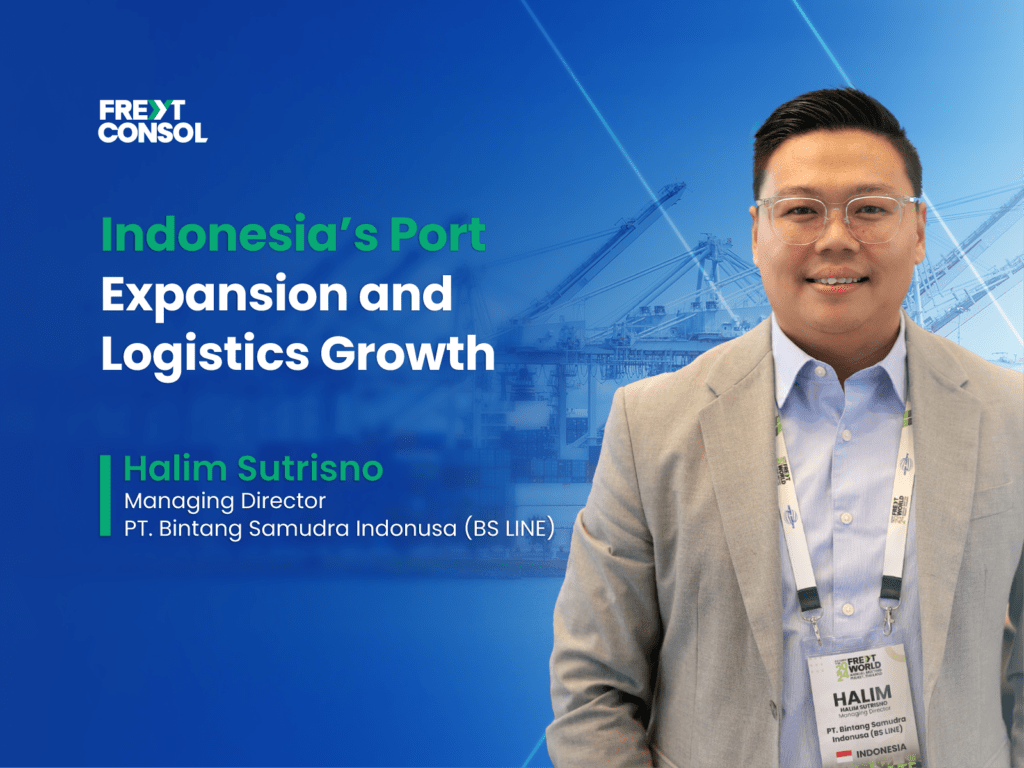02 Apr 2025
Jakarta Port Expansion and Logistics Growth: Strategic Opportunities and Implications
By Halim Sutrisno, Managing Director of PT. Bintang Samudra Indonusa

Indonesia's maritime infrastructure is in a transformative phase, characterized by endeavors like the Jakarta International Container Terminal 2 (JICT 2). These expansions are critical in boosting the nation's capability to handle increased trade volumes. They are also instrumental in fostering government investment across the logistics sector. As Indonesia sets its sights on enhancing its role within global supply chains, these infrastructural developments provide significant benefits for freight forwarders. The anticipated enhancements in efficiency, capacity, and growth opportunities position Indonesia as a focal point for Southeast Asian economic activity.
Beyond raw capacity increments, these infrastructural projects bring sophisticated digital integrations and infrastructural upgrades. These upgrades promise a smoother flow of goods, reduced wait times, and improved service reliability. Freight forwarders are poised to capitalize on these improvements, navigating an environment that is faster and more responsive to global trading demands.
Jakarta’s Expanding Port Infrastructure
Jakarta remains Indonesia's primary maritime gateway, providing essential connectivity to global trade routes. The Port of Tanjung Priok is a central pillar in this network, ranking among the world's top 25 busiest ports. Handling more than half of Indonesia's international cargo, it significantly contributes to major shipping corridors between Asia, Europe, and within Asia itself. Its pivotal location near the Malacca Strait—responsible for 30% of global maritime trade—underscores Jakarta’s status as a primary transshipment hub. This strategic placement enhances connection between East Asia’s manufacturing giants and key markets across South Asia, the Middle East, and Europe.
The expansion at Jakarta’s ports—namely JICT 2 and New Priok Port—focuses on allowing ultra-large container vessels (ULCVs) to dock. This move reduces reliance on hubs in neighboring countries, such as Singapore and Malaysia's Port Klang. Additionally, the seamless integration of these ports with leading digital platforms, such as Inaportnet, enhances cargo visibility and streamlines customs operations. The strategic proximity of Jakarta to the industrial zones in West Java and Sumatra ensures that manufacturing clusters have direct export paths, further establishing Jakarta as a crucial logistics node in the global network.
The Importance of Jakarta Port Expansion
The enhancement of the Port of Tanjung Priok is vital for the country's trade strategy. Handling an impressive 2.2 million TEUs annually, the Jakarta International Container Terminal (JICT) is poised for further growth with JICT 2. Projected for completion in 2026, this $13.6 million project plans to add 500,000 TEUs of annual capacity. The expansion will include a 500-meter quay with deeper docks, enabling accommodation for larger container vessels, thus reducing vessel wait times and enhancing the logistics service reliability by 2027.
Meanwhile, the New Priok Port (Kalibaru) sets ambitious goals to triple Tanjung Priok’s capacity, aiming for 18 million TEUs by 2030. With the backing of a $2.47 billion investment, this project will introduce three new terminals with automated systems for cargo handling to accommodate demand surges. These strategic upgrades position Jakarta as a formidable alternative to existing regional hubs for Asia-Europe and intra-Asian routes.
Jakarta Port Expansion Boosts Capacity and Efficiency
Indonesia's logistics sector is projected to witness a growth surging over 6% annually, bolstered by thriving e-commerce and infrastructural investments. The government’s focus on digitalization appears crucial in this arena. Platforms such as Inaportnet and SIMLALA automate vital customs and cargo tracking functions, offering freight forwarders real-time visibility into shipments. Such initiatives reduce delays typically caused by manual processing and ensure a streamlined, efficient supply chain—it’s this combination of technology and infrastructure that defines Jakarta’s renewed logistical might.
Moreover, the recent establishment of a new gateway facility in Denpasar, Bali, operational since October 2024, offers direct routes to Singapore. This new setup allows certain shipments to bypass Jakarta, thus supporting specialized cargo such as Class 9 dangerous goods. These capabilities significantly shorten transit times for freight moving between Bali and key ASEAN markets, offering alternate routing solutions for agile freight forwarders focused on speed and efficiency.
Infrastructure Investments and Digital Integration
Indonesia’s economy is progressively diversifying, powered by a digital sector poised to surpass $130 billion by 2025. In embracing the EU Regulation on Deforestation-Free Products (EUDR), Indonesia demonstrates its commitment to sustainable development. With compliance deadlines extended to December 2025, exporters must implement rigorous traceability measures. Ensuring that commodities like palm oil and timber align with these standards is pivotal to avoid disruptions in the EU market, with freight forwarders at the forefront ensuring compliance and smooth operational transitions.
The National Long-Term Development Plan emphasizes sustainable trade, supporting initiatives like green ports to reduce emissions actively. These innovative practices align logistics hubs with global environmental standards. They ensure Indonesia’s ports meet efficiency benchmarks and contribute positively to carbon footprint goals. This approach appeals to forwarders with sustainability objectives.
Opportunities and Strategic Advancements
With Tanjung Priok’s smart port upgrades embracing IoT-enabled energy management systems, Indonesia's ports align seamlessly with global sustainability goals. The extended capabilities allow freight forwarders to optimize load management and consolidate shipments for mega-vessels. These large shipments lower per-unit costs across long-haul routes, offering a compelling value proposition for businesses looking to optimize logistics cost without sacrificing service quality. Additionally, new direct lanes like Bali to Singapore provide vital speed advantages for time-sensitive goods, fulfilling niche demands in industries that are highly time-dependent.
There is a powerful opportunity for forwarders to enhance their service offerings through specialized cargo handling. Enhanced facilities accommodating dangerous goods and perishables, evidenced by Bali’s new gateway, establish Indonesia’s ports as crucial enablers for niche industries like pharmaceuticals and agricultural products. As Indonesia pushes to become a regional trade leader by 2025, these facilities will anchor the country’s ambitions by meeting complex logistical requirements.
Jakarta Port Expansion: Enhancing Specialized Cargo Handling
Strategies that drive Jakarta's port expansions include ensuring the infrastructure supports forwarders catering to specialized markets. By enabling the efficient handling of specific cargo types—such as perishables and hazardous materials—Jakarta’s ports can offer unique services that help forwarders capture market segments with specialized needs. This focus on niche markets complements the broader strategy of expanding general cargo capacity, presenting opportunities for diverse business pursuits.
Indonesia's logistics ecosystem is evolving, and these port expansions are crucial to safeguarding against logistical challenges. Balancing logistical growth with regulatory compliance remains integral to realizing these opportunities. Freight forwarders must deftly navigate regulatory terrains, balancing the pursuit of growth against potential congestion challenges and compliance requirements.
Balancing Growth with Regulatory Challenges
As Indonesia progresses with its infrastructure projects and digital advancements, freight forwarders must adapt to a dynamically shifting regulatory environment. Jakarta’s expanded port capacity and Bali’s strategic developments give forwarders the tools they need to remain competitive. By leveraging these infrastructure developments, they can ensure efficient service delivery and cost advantages. However, staying ahead of regulatory changes is necessary for fostering growth.
Striking an equilibrium between capitalizing on growth opportunities and managing potential risks related to congestion is critical. To harness Jakarta port expansion benefits and ensure consistent, reliable service, forwarders must integrate these new capabilities seamlessly into their operations. This integration requires proactive adjustments and a forward-looking strategy, aligning with Indonesia’s broader economic objectives.
Ensuring Competitiveness in Southeast Asia
To thrive in Southeast Asian markets, freight forwarders must leverage the new infrastructure developments tied to Jakarta’s port expansions. These advancement projects provide robust support, ensuring competitive service offerings amidst an evolving global trade landscape. Moreover, these strategic infrastructure enhancements reflect the Indonesian government's commitment to bolstering its logistics framework.
These improvements catalyze economic growth and strengthen Indonesia’s role in regional and international supply chains. By focusing on expanding logistical capabilities, Indonesia positions itself for a promising economic future. It serves as a fulcrum for sustainable and efficient global trade operations. As the nation prepares for more global market participation, forwarders with advanced tools will be key. They will foster seamless trade connections across continents.

Freyt Consol Blog Contributor
Freyt Consol is a global network for LCL consolidators and NVOCCs dedicated to excellence and long-term growth. We create an environment where members thrive by collaborating with trusted partners and accessing essential resources.




